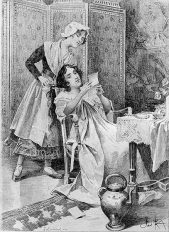
A Second Home
THE HUMAN COMEDY – Honoré de Balzac First volume of works of Honoré de Balzac edited by widow André Houssiaux, publisher, Hebert and Co, successors, 7 rue Perronet – Paris (1877)
Scenes from private life 
A SECOND HOME
Written in early 1830
Analysis of the work Written on the same date as Vendettain early 1830, A Second Home is perhaps the perfect example of what Balzac wanted to do in the Scenes from private lifeTo teach, and also to show the individuality of a private life, to show how morals, home, furnishings and clothing are the signs that allow us to guess a character and define a mentality. It’s another story of a bad marriage. The scene begins in Bayeux, Normandy. A young magistrate (Roger de Granville) marries a young girl (Angélique Bontems) from a good, well-bred family. He just thinks she’s pious, when in fact she’s a bigot. He was appointed to Paris. She tastefully arranged a cold, austere home for him. She imposed on him a life of abstinence, a coldness, a rigor of observance that appalled him. He detaches himself from her and meets a poor girl, Caroline Crochard, who takes a liking to him. He sets her up in a cozy apartment to suit his own taste. “When you marry,” said the magistrate to his son, “don’t do it lightly. Remember to study for a long time the character of the woman with whom you are to associate. This is morality.” His wife, Mme de Granville, learned of the affair and further widened the gulf between the couple. The couple had two children, Charles and Eugénie. Caroline will abandon the Count for a handsome young seducer named Solvet. This sinister character is penniless, a gambler, loves women and wine. For the love of this man, Caroline will sacrifice her fortune, her health and that of her children. Misery won out over the family, and the Count, aged and embittered by all his suffering, retired alone to Italy. The story is about this double life and the serious consequences it entails. That’s morality. Descriptions that make everything clear are the method Balzac invented and would employ in all his novels. “The author firmly believes,” he says in a note, “that details alone will henceforth constitute the merit of works improperly called novels.” Bayeux, a devout town, the parlor in the rue Teinture house, the visits of ecclesiastics, the cool tones, the practices of piety, are an admirable presentation that has remained famous. The same tones, the same austerity, the same impersonality are found in the installation that the young wife had made in Paris. In contrast, Balzac shows the mistress’s apartment as the setting for a youthful, cheerful life. Like any animal, man secretes a shell whose iridescence reveals his character. Every private life thus has a “hue”, and the novelist’s task is to describe it. Balzac had gone to see for himself, and Laure, his beloved sister, had followed her husband Eugène Surville to Bayeux, where he was a civil servant in the Ponts-et-Chaussées department. Balzac spent the summer vacations of 1822 with them: they lived in rue Teinture. But it is Balzac’s personal experience that gives the story its grave significance. As Balzac knew, his mother had been the mistress of their friend M. de Margonne, and from this affair had fathered her son Henri, Balzac’s favorite younger brother. He had learned that adultery is a secret theft of patrimony and, more seriously, a misappropriation of maternal affection. M. de Margonne’s wife was, it seems, a nasty little bigot, quite disagreeable. The disasters at the end of the novel show the dramatic consequences of adultery and adulterous children. His wife, Mme de Granville, learned of the affair and further widened the gulf between the couple. The couple had two children, Charles and Eugénie. Caroline will abandon the Count for a handsome young seducer named Solvet. This sinister character is penniless, a gambler, loves women and wine. For the love of this man, Caroline will sacrifice her fortune, her health and that of her children. Misery won out over the family, and the Count, aged and embittered by all his suffering, retired alone to Italy. Paris, February 1830 – January 1842
Preface from Volume III, based on the complete text of the Comédie Humaine published by France Loisirs 1985 under the auspices of the Société des Amis d’Honoré de Balzac.
Genealogy of characters Granville: (Roger de) Grandson of the President of Parliament, Roger born in 1779, lawyer, then magistrate and peer of France, married Angélique Bontems in 1806, born in 1787, from whom : A son born in 1807 who became a magistrate in Limoges; Eugène, who became King’s Attorney; Marie-Angélique born in 1808 who married Félix de Vandenesse in 1828; Marie-Eugénie born in 1814, who married Ferdinand du Tillet. From his affair with Caroline Crochard, known as de Bellefeuille, Granville had two natural children, Charles and Eugénie. Bontems: Owner in Bayeux, married a devout woman, hence : A daughter who died in 1805; Angélique married Granville. Crochard: Dancer, then colonel, he died in 1814. Father of Caroline dite de Bellefeuille. From her affair with Attorney General Granville, she has two children. Solvet: Caroline Crochard’s lover.
Source for character genealogy: Félicien Marceau “Balzac et son monde” (Balzac and his world).
No Comments